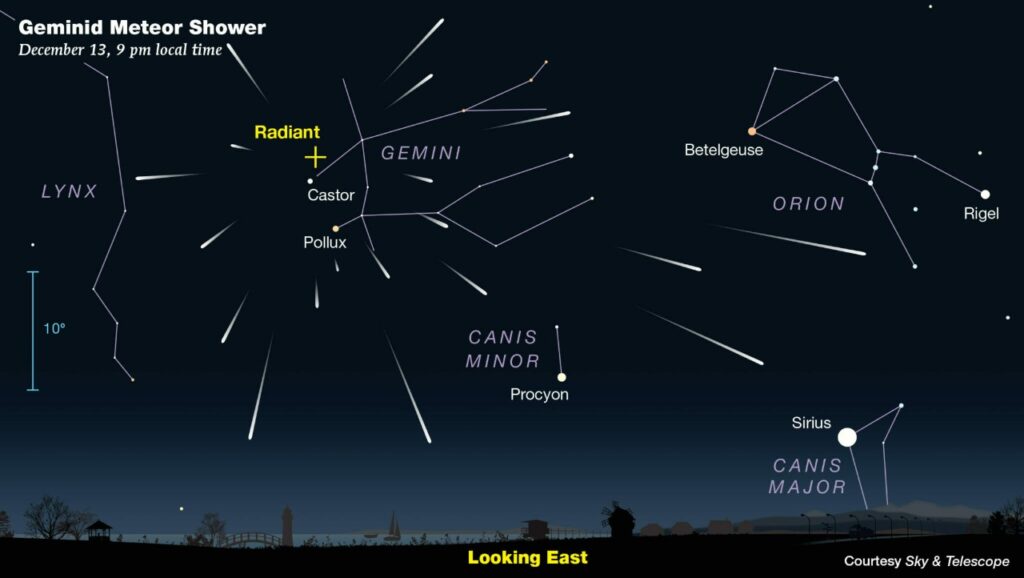1. Be sure you know which days the shower will peak.
Meteor showers happen over many days, as Earth encounters a wide stream of icy particles in space: debris left behind by a comet. The peak is just what it implies. It’s a point in time when Earth is expected to encounter the greatest number of particles from a particular meteor stream. In 2021, the peak mornings for the Perseids are August 11, 12 and 13. To find the peak dates of other meteor showers, try EarthSky’s meteor guide for 2021. Be aware that most, but not all, meteor showers are best after midnight.
2. Find out the time of the shower’s peak in your time zone.
You don’t need to watch exactly at the peak time. But it can help you decide which night is absolutely best for you.
Different sources might list different times for the peak of a meteor shower. In that case, go with a source you trust. Here at EarthSky, we trust the Observer’s Handbook from the Royal Astronomical Society of Canada. Predictions are not always spot on. And do be aware that the peak typically stretches over a day or so. The Observer’s Handbook gives the peak time for the Perseids as August 12 at 19:00 UTC. So you could watch on the mornings of August 12 or 13. We recommend watching on August 11, too, because the Perseids are known to rise gradually to a peak and then fall off rapidly.
3. Watch on the nights around the peak, too.
If you miss a shower’s peak, you might not see as many meteors. But don’t let that discourage you! As we’ve mentioned before, predictions for meteor shower peaks are not always right on the money. It’s possible to see very nice meteor displays hours before or after the published peak. For example, who can forget the famous 1998 Leonid meteor shower? The predicted peak favored observers in Europe, and yet those of us in the U.S. were nevertheless treated to wonderful displays of Leonids on the nights before and after the predicted peak.
Just remember, meteor showers are part of nature. They often defy prediction.
4. Understanding the shower’s radiant point can help.
A meteor shower’s radiant point is that point in the sky from which the meteors will appear to radiate. Some people seem to think they have to be able to identify the radiant point in order to be able to watch the shower, but that is a serious misconception. You can see meteors shoot up from the horizon before a shower’s radiant has even risen into the sky.
Here’s the power of the radiant point. Once it has risen into your sky, you’ll see more meteors. When it’s at its highest overhead – assuming you’re watching at a time when the shower has been producing meteors steadily over many hours – you’ll see the most meteors.
So find out the radiant point’s rising time. It can help you pinpoint the best time of night to watch the shower.
5. Find out the shower’s expected rate or the number of meteors per hour.
Here we touch on a topic that often leads to some bad feelings, especially among novice meteor watchers. Tables of meteor showers almost always list what is known as the zenithal hourly rate (ZHR) for each shower.
The ZHR is the number of meteors you’ll see if you’re watching in a very dark sky, with the radiant overhead, when the shower is at its peak. In other words, the ZHR represents the number of meteors you might see per hour given the very best observing conditions during the shower’s maximum.
Now let’s apply this term to a real-world example. In 2021, the Observer’s Handbook gives a zenithal hourly rate for the Perseid meteor shower of 90. That doesn’t mean you’ll see 90 meteors per hour, but it does mean you might if you’re watching on a peak night in a dark sky, when the radiant is highest.
6. You must be aware of the phase of the moon.
If the moon is at a quarter phase or greater, you’re going to miss meteors, even if your skies are otherwise dark. It’s okay if the moon sets before the radiant rises because the Earth blocks the moon’s light from the sky. But nothing dampens the display of a meteor shower more effectively than the presence of a bright moon. Luckily, as mentioned above, the moon is not a factor for the Perseid meteor shower in 2021.
7. Dress warmly.
The nights can be cool or cold, even during the spring and summer months.
8. Bring along that thermos of hot coffee or tea.
It’ll be your friend at 3 a.m.
9. Bring a blanket or lawn chair for reclining comfortably while looking up at the sky.
If you’re observing with a friend, set your chairs out back-to-back, and look at different parts of the sky. Then when one of you sees a meteor, he or she can call out “meteor,” and everyone can turn and look.
10. Relax and enjoy the night sky.
Not every meteor shower is a winner. Sometimes, you may come away from a shower seeing only one meteor. But consider this. If that one meteor is a bright one that takes a slow path across a starry night sky.


